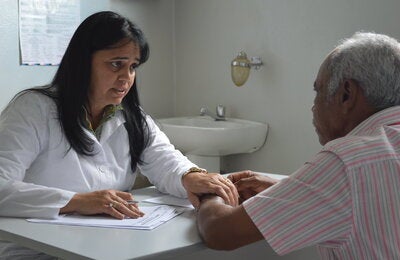
PAHO launched a series of diabetes country profiles illustrating the rising burden of diabetes and diabetic kidney disease for countries in the Region of the Americas. The country profiles reveal that during the last 20 years, disability due to diabetes (excluding diabetic kidney disease) increased in all countries of the Region, both in men and women, while diabetic kidney disease increased in 31 of the 33 countries analyzed.
Diabetes is a major cause of ill health, disability, and death, with an estimated 244,084 people dying from diabetes in the Americas. The number of people with diabetes has increased substantially over the past 30 years from 18 million to 62 million today. However, this is likely an underestimate of the number of people who need access to diabetes care, since approximately 40% of people do not know they have the disease and are still undiagnosed.
Growing rates of obesity, poor nutrition, and a lack of physical activity contribute to explaining the increase in the number of people with diabetes. The Americas shows a prevalence of overweight/obesity of 63% and insufficient physical activity of 39%. With these numbers, the Americas has the highest rates of obesity and physical inactivity worldwide.
Unfortunately, mortality and disability from diabetes have also increased exponentially in the Americas in the last two decades. Diabetes (excluding diabetes-related CKD) is today the sixth leading cause of death and the second leading cause of years lived with disability. Consequently, the Region of the Americas is the one with the highest burden of disease due to diabetes in the world.
To provide evidence that helps the development and assessment of health strategies to deal with diabetes, PAHO carried out a trend analysis of the burden of diabetes and diabetic kidney disease between 2000 and 2019. Unfortunately, the analyses show that the years lived with disability increased during this period with an average rate of 2.1% per year in men, and 1.8% per year in women. On the other hand, the years lived with disability due to diabetic kidney disease increased annually by 0.6% in men and 1.1% in women.
The rapid increase in the burden of diabetes and diabetic kidney disease reflects insufficient prevention, late diagnosis of diabetes and its complications, and poor metabolic control of the disease. It is necessary to take three urgent actions to enable people with diabetes to live healthier lives and avoid complications:
- Improve the capacity of primary health care for early diagnosis, treatment, self-management, and prevention of diabetes-related complications.
- Increase access and availability of quality diabetes care, including essential medicines and technologies for diabetes management.
- Develop healthy policies to promote healthy lifestyles and nutrition, including front-of-package labeling, and taxation of sugar-sweetened beverages, among others.
PAHO works with Member States to support the adoption of effective public health interventions for the prevention, control, and surveillance of diabetes, in the context of a comprehensive approach to noncommunicable diseases, and focusing on the integration of noncommunicable diseases into primary health care.
PAHO DIABETES COUNTRY PROFILES



